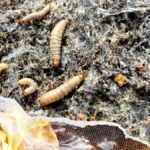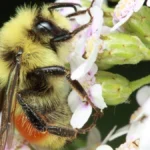In nature, all manner of special tricks are employed by different species to gain advantages. Looking like a bee or a wasp can be useful as other animals have learned that bees and wasps hurt them. There are a number of types of moth that looks like a bee. In this article, we look at how these “bee moth” mimics work.
Evolutionary Mimicry In Nature
In nature, many examples exist where one species mimics another for benefit. If we take the example of bees and wasps, many tend to look similar with yellow and black stripey appearances. These animals have dangerous stings and birds learn rather quickly that stings are not a good thing.
If another palatable species lives in proximity to bees and has a few features that make it look like a bee it will gain some advantage out of this. Birds will think that it is not edible and avoid it. Over time, the individuals in that species that look more and more bee-like will be selected. The ones that look less bee-like will get eaten. In time this will result in the mimic becoming better and better at appearing to be a bee.
This is known as Batesian mimicry.
There are many moths that mimic bees – this allows the moths a number of advantages. In many cases, it allows them to fly during the day. Many moths are nocturnal to avoid predation. In the case of mimics that look like bees, they can fly safely during the day. In this article, we will take a look at a few of the more commonly found moths that mimic bees.
The Strawberry Crown Moth
The bee mimic Synanthedon bibionipennis is found in western North America. If we look at the natural insect populations of North America, honeybees are a recent introduction. The mimicry we see in this area is more often evidenced in moths that have evolved to look like yellow jacket wasps or bumblebees. The same lessons a predator learns from a yellow jacket it will however also learn from a bee.

This moth has bright yellow stripes on it, and has clear wings, making it possible for a predator to mistake it for a wasp or bee.
The Genus Hemarus – The Clearwing Moths
These moths in the genus Hemaris are known collectively as clearwing moths or hummingbird moths in the US and Canada and bee hawk-moths in Britain. These moths often have a resemblance to bees and wasps and are able to avoid certain predators because of this. This is a nice video so you can see how they fly and hover. Incredible animals. I remember for years trying to identify a “bee” that would come to my basil plants, only to find out it was a moth!!
Bumblebee Moths
In North America, bumblebees are a natural species and can sting. Many indigenous species of moth have evolved to mimic bumblebees and are loosely called the Bumblebee moths.
The Yellow-Banded Day Sphinx
This moth has an uncanny resemblance to a bumblebee. You may actually find that many of the things you thought were bumblebees in your garden can actually be a mimic such as this one.
The Snowberry Clearwing
The Snowberry Clearwing, or Hemaris diffinis, is a widely distributed bumblebee mimic found over much of North America. It bears a strong resemblance to a bumblebee and uses this to its advantage, foraging by day on nectar. These moths can also be nocturnal.
The above list contains a few examples of different moths that look like bees, bumblebees, or wasps. There are many more, and this makes for an interesting project to read up on.
We can see in these examples that moths have evolved to take advantage of looking like bees. But what if there is a moth that can evolve to trick bees into looking after it? This brings us to a final rather fascinating moth – the Deathshead moth.
The Deathshead Moth
The first time I saw one of these I was blown away by how crazy it looked. I saw a big black moth with a skull on its back fly up to one of my hives. Normally bees hate any moths and will tear them to pieces. This moth just went to the hive and walked right in. I opened the hive and watched as it rummaged around the inside of the hive, drinking nectar and being a generally bad guest. It made little chirp sounds and seemed to call the workers to feed it much as a queen would.
After it had fed, it left the hive and flew away into the evening sky making a screaming noise. The sound that it makes is enough to send shivers up the spine.
This moth is a different form of evolutionary mimic. It has evolved to mimic the smell of bees and queens so that it can parasitize hives and rob these hives of honey. The moth has additional tricks up its sleeve. Larval stages often feed on toxic plants of the nightshade family. The larvae accumulate the toxins in the plants, and consequently, predators are killed if they eat the larvae.

A deaths head month I found in one of my hives in 2008. Photograph courtesy of my Dad, Dr. JA Cambray.
Protection Of Hives By A Parasite
In much of Africa, the Deathshead moth is believed to be a representative of evil spirits. In isiXhosa, the language of the late Nelson Mandela, the moth is known as the Vivingani and honey gatherers will hear the moth squeak in a hive when they introduce smoke to calm the bees. Hives containing a Vivingani will be avoided as there is a belief that the evil spirits that the moth represents will bring plague and death.
In the British Isles, this 5-inch wingspan moth is the largest moth species. In ancient times, droughts in North Africa would result in the moths flying to the British Isles. The moths were associated with plague and famine. Interestingly, dry conditions in North Africa are often associated with poor weather in the British Iles, hence this was a relatively accurate superstition.
I hope this article has helped you see the magical world of moths that mimic and even parasitize bees. We truly live on an amazing planet, and these creatures confirm that. Share if you enjoyed it.
Read more about: How To Get Rid Of Wax Moths In Beehives
Moths That Look Like Bees FAQs
What is Batesian mimicry?
Batesian mimicry is when a harmless species imitates the appearance of a harmful species to avoid predators. For example, many moths mimic bees or wasps to gain protection from animals that have learned to avoid stinging insects.
Why do moths mimic bees?
Moths mimic bees to avoid predators. By resembling bees or wasps, which are known to sting, these moths can fly during the day safely, as predators mistake them for harmful insects.
Which moths look like bees?
Several moths mimic bees, including the Strawberry Crown Moth, the Bumblebee Moth, the Snowberry Clearwing, and species from the genus Hemaris, also known as Clearwing Moths.
What is the Strawberry Crown Moth?
The Strawberry Crown Moth (Synanthedon bibionipennis) is a moth found in western North America that mimics bees or wasps to avoid predators. Its yellow stripes and clear wings help it blend in with stinging insects.
What are Clearwing Moths?
Clearwing Moths belong to the genus Hemaris and are often called hummingbird moths or bee hawk-moths. These moths have transparent wings and resemble bees or wasps, allowing them to evade predators.
What is a Bumblebee Moth?
Bumblebee Moths are a group of moths in North America that have evolved to look like bumblebees. Their resemblance helps them avoid predators, as bumblebees are known for their painful stings.
What is the Deathshead Moth?
The Deathshead Moth is a large, black moth with a distinctive skull-like marking. It has evolved to mimic the smell of bees, allowing it to enter beehives undetected and steal honey.
How does the Deathshead Moth survive in beehives?
The Deathshead Moth produces sounds and emits pheromones that trick bees into thinking it’s a queen. This allows the moth to feed on nectar inside the hive without being attacked by the bees.
Why is the Deathshead Moth considered a bad omen?
In many cultures, especially in Africa and Europe, the Deathshead Moth is associated with bad luck, death, and famine. Its eerie appearance and behavior have contributed to its ominous reputation.
Can moths that mimic bees be harmful to bees?
While most moths that mimic bees do so to avoid predators and are harmless, the Deathshead Moth parasitizes beehives, stealing honey and sometimes spreading disease, which can harm bee colonies.

Dr. Garth A. Cambray is a Canadian/South African entrepreneur and beekeeper with 28 years of experience in apiculture and specializes in adding value to honey. His Ph.D. research developed a new advanced continuous fermentation method for making mead that has resulted in a number of companies globally being able to access markets for mead. His company, Makana Meadery, exports honey mead to the USA where it is available to discerning connoisseurs. He has also developed technologies to commercially manufacture organic honey vinegar in Zambia for export globally. He holds a few patents globally in the ethanol industry and believes in technology and knowledge transfer for human development and environmental sustainability. One of his proudest achievements is the fact that the wind farm he started at one of his old apiary sites has essentially made his hometown carbon neutral.






